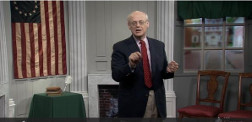“America’s Founding Fathers,” an intriguing course that looks at a narrow slice of U.S. history, is a series of 36 video lectures from The Great Courses Plus. The course begins with the conclusion of the Revolutionary War, then explores the aftermath of that war and the challenges facing the new country.
The course deals extensively with issues often glossed over in U.S. history survey courses, issues such as the inadequacy of the Articles of Confederation, the crippling debt owed after the war, and the battle between federalists and those anxious about states’ rights. Our Founding Fathers were entangled in political, economic, cultural, philosophical, and religious issues that made the fledgling nation's continued independence a real concern.
Professor Allen C. Guelzo presents the historical issues as serious questions, generally with worthy arguments presented by those with conflicting views. The course begins with the lecture “George Washington’s Doubts.” Given that the U.S. Constitution was an unproven experiment and the history of other republics was not terribly encouraging, it was natural for even those most loyal to the project to have their doubts as did Washington. There were many ways in which the noble experiment could have failed.
Professor Guelzo humanizes his lectures through stories and biography as you can see from the titles of the lectures such as, “Thomas Mifflin’s Congress,” “Robert Morris’s Money,” “Benjamin Franklin’s Leather Apron,” “Thomas Jefferson’s Books,” and “Daniel Shay’s Misbehavior.” The course concludes with the observations of Alexis de Tocqueville, identifying positive traits of the American republic while raising vital questions about its ability to endure, questions that are even more pertinent today than when he wrote.
Stories are even used to explore serious topics such as the influence of Britain’s mercantilist economics. In this case, Professor Guelzo shows how Britain’s stranglehold on coined money caused the fledgling United States to be rich in land but poor in “portable” wealth. Because of this, financing debt from the American Revolution proved a thorny problem that caused huge conflicts between the states.
Professor Guelzo’s oratorical gifts shine in this course. He is delightful to listen to, especially when he presents the actual words of historical figures as they might have expressed them. He easily and frequently segues from his own lectures into brief speeches featuring the words of influential characters. His literary allusions make the lectures even more interesting, but students who don’t catch these should still grasp the concepts.
The course was created in partnership with the Smithsonian Institute. Consequently, it includes images of artifacts from the Smithsonian’s collections. While images enrich the course and the video version of the course is preferable, there’s no significant loss of essential content with only the audio.
A free, downloadable, 309-page guidebook can be accessed from the course page online. The guidebook is essentially the script for the course, although there seem to be significant chunks of material in the lectures that are skipped in the guidebook. The guidebook has two or three questions for each lecture. Students should either discuss or write out responses to these questions. For example, two questions for the lecture “James Wilson’s Executive” are “1. What were James Wilson’s arguments in favor of a single-person executive?” and “2. What arguments were put forward for direct election of the executive?” (p. 124). As you can see, these questions will typically require essay-type responses rather than brief answers.
Students should be able to complete this course in less than a semester. Because it is limited in both scope (the amount of U.S. history covered) and time required, you need to combine it with other material for a complete high school level course.
You might consider using John Degree’s Take A Stand guide American History from the American Revolution to 1914. This guide provides a research and writing component that fits very well using the first six of its thirteen lessons alongside “America’s Founding Fathers.”








